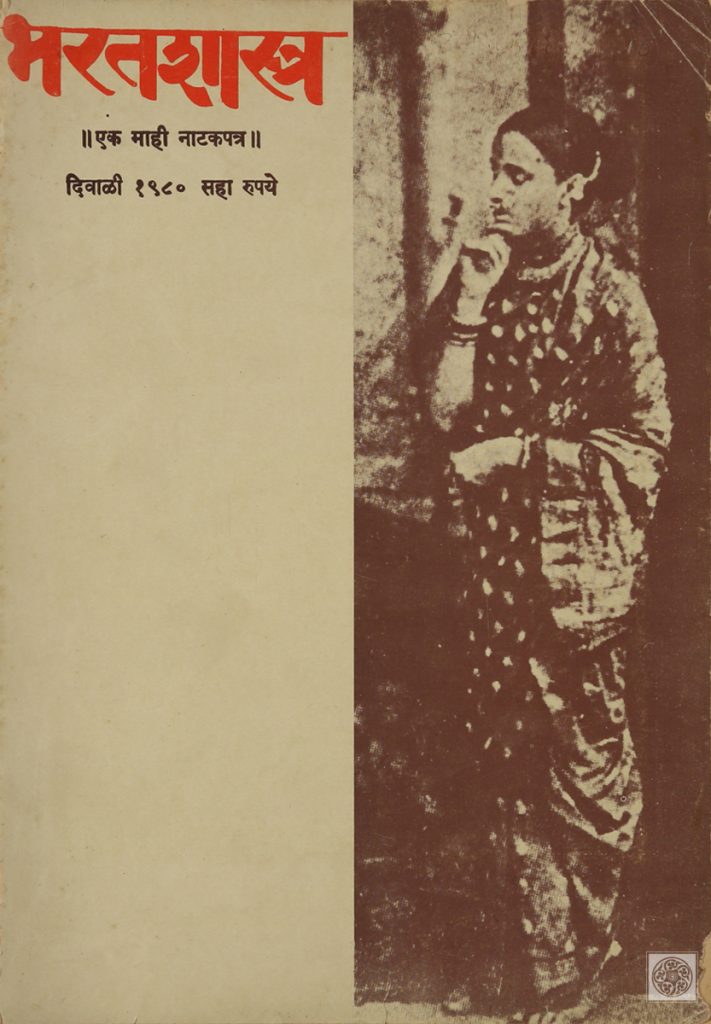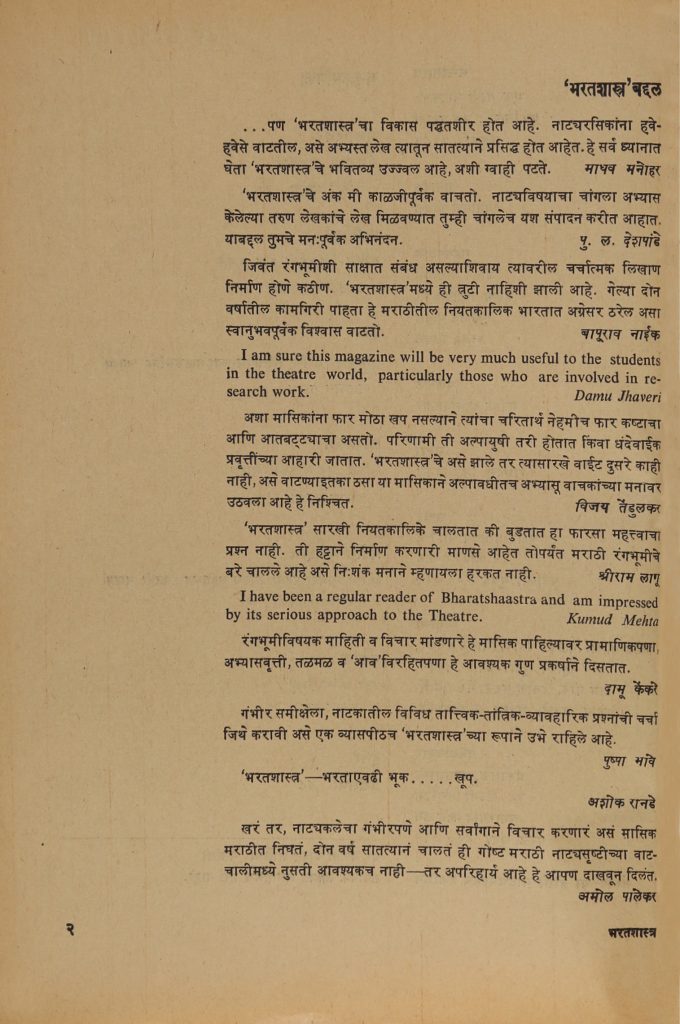Tracing Theatre Criticism in Mumbai’s Marathi Monthly Periodical Bharatshastra (1978-1984)
In this series of Notes from the Archive – Print & Theatre, the Alkazi Theatre Archives looks at a Marathi theatre monthly, Bharatshastra (1978-84), published from Parel, Mumbai and edited by Vinayak Padwal, to analyze the nature of theatre news and criticism. Theatre criticism in Maharashtra was limited to seminars and conferences in isolated pockets. In order to address this lack of well organised theatre criticism, ‘Sankalp’- an amateur theatre group, started publication of Bharatshastra in September 1978. It can be said that through Bharatshastra, the group was attempting to bring theatre criticism into the public sphere employing the comparatively accessible print medium. But, why is theatre criticism important? Can news, essays, and reports on theatre be analyzed to comprehend what constitutes theatre in a given time? Can theatre criticism and reportage, through their citationality of performances, enable one to analyse the emergent themes in the theatre practice and in turn, aid in the development of theatre?
Cover SlideCovers of Bharatshastra, Marathi theatre monthly, at the Alkazi Theatre Archives
The editorial of the September 1980 issue of Bharatshastra underlines the objectives of the monthly so as to provide criticism on contemporary plays, production reviews, discussion on different elements of theatre, the introduction of theatre personalities and institutions, writing on theatre history and its codes, and publishing analytic and comparative studies. Moreover, it also highlights an important feature of theatre criticism – prioritizing production reviews, keeping in mind that theatre is not just a literary form, but also an experiential work of art.
The Diwali Issue of 1980 carries an essay by Shyamala Vanarase in the ‘शिक्षण–प्रयोग–समीक्षा’ (Education-Production-Criticism) section on nature and need of theatre production reviews. The essay is titled ‘नाट्यप्रयोग समीक्षा: प्रयोगरचनेचा विचार’ (‘Theatre Production Review: Thinking Through Production Composition’). The author points out that often, a reviewer of a theatre production tends to walk a thin line between a production review and a drama review and ends up writing a drama review instead. Vanarase urges the reader, reviewer as well as theatre-makers to think through the production composition independent of its ‘text’, thus, recording the ephemeral experiential work and making a dialogue between theatre-makers and theatre critics possible. For such a symbiosis to take place, Vanarase suggests that the directional choices of acting techniques, direction styles, light design, mise-en-scene and costumes should be included in theatre critics’ reviews and analysis. She writes, “प्रयोगशैलीमधे स्थल, काल, आणि अभिनय यांची विशिष्ट सूत्रे अंतर्भूत असतात. मराठी रंगभूमीची परंपरा पहिली तर गृहीत धरलेल्या चौकटी आणि त्यातून निघणारा ‘खेळ‘ त्यांचे अनेक प्रकार दृष्टीस पडतात. केवळ आशयाच्या दृष्टीने नवी किंवा धाडसी अशी पाठ्याची परंपरा प्रयोगांना नवे वळण देईल असे नाही. परंतु कोणती उपतंत्रे वापरावी किंवा वर्ज्य समजावी याबाबतही धाडसाचे अनेक प्रकार या इतिहासात दिसतील. या तत्वांच्या आधारे प्रयोगांची समीक्षा केल्या प्रयोगकर्ते आणि समीक्षक यांना एकाच पट्टीत संवाद करणे शक्य होईल. ते विकासाच्या दृष्टीने कलाव्यवहरातील एक आवश्यक पाऊल ठरेल” (page 70)
English Translation:
“The production style and composition includes within itself specific formulas for place, time and acting methods. If we look at Marathi theatre tradition closely, one can see the taken for granted frameworks and the resulting ‘play’ from them. A new or bold text in terms of its content alone cannot give a new twist to the production. However, this same theatre history will also give a sense about which sub-techniques are useful and those that are considered a taboo. If the production reviews are written based on these principles, both the reviewer/critic and the theatre-maker can find middle ground to open up a conversation. And it will be a necessary step in the development of art”.
Shyamala Vanarase’s essay on Production Reviews in Bharatshastra (Diwali Issue, 1980)
By looking at Vanarase’s essay, one can say that through theatre criticism, the monthly was enabling a dialogue between the makers and the commentators, balancing the practical and the theoretical. Bharatshastra included essays on ‘modern’ theatre as well as ‘folk’ theatre forms, discussing its aesthetics and introducing the readers to its writers, theatre-makers, and performers.

Diwali Issue of Bharatshastra in 1980 commemorating 100 years of Sangeet Natak (musical drama form of Maharashtra)
In the Diwali Issue of 1980, the monthly included a separate section on Folk Theatre including essays on the form of tamasha and the relationship between folk theatre and urban stage. Such writings not only enabled possible fusions, but also ethnographically documented what was ‘popular’ in the urban centres as opposed to the periphery. In critically engaging with folk theatre, the monthly recorded its changing nature by historicizing the form in the contemporary and theorizing on the relationship between urban-modern and rural-folk cultures.
The monthly also published a section called ‘प्रासंगिक’ (Of Relevance) where it discussed and critically examined recent theatre developments and trends, thus creating an awareness as well as a commentary on a particular issue and its influences on the theatre scene. The above-mentioned Diwali issue of 1980 also published an article titled “Has the Marathi Sangeet Natak evolved?” by Dnyaneshwar Nadkarni in the ‘Of Relevance’ section. Repeatedly asking the question, “मराठी संगीत नाटक आहे कुठे?” (Where is the Marathi Sangeet Natak today?), Nadkarni gives an overview of the hundred years of musical theatre, explaining the use of the form from Annasaheb Kirloskar’s Sangeet Shakuntal (1880) to recent productions of Vijay Tendulkar’s Ghashiram Kotwal. Bringing to fore recent attempts at making a Sangeet Natak, the essay concludes with an appeal for new original writings which create a symbiotic rhythm between theatre, poetry and music, as required by the form. This essay also places ‘modern’ plays like P. L. Deshpande’s Teen Paishacha Tamasha, Vijaya Mehta’s Aantar-rashtriya, Ratnakar Matkari’s Lokkatha ‘78, etc. in the tradition of Sangeet Natak rather than in the Theatre of the Roots movement.
Nadkarni writes, “ नाट्य, काव्य आणि संगीत यांच्या संदर्भात एवढे सगळे आलिकडे आशादायक होत असले तरी मराठी संगीत नाटक आहे कुठे?…पारंपरिक संगीत नाटक, नव्या फॉर्मचे संगीत नाटक, कोणत्याही प्रकारचे खणखणीत, साच्चे संगीत नाटक आज भोवताली दिसत नाही. संगीत नाटकाचा शताब्दी मोहत्सव साजरा करताना या फॉर्मचा अपुरा अभ्यास, गायक कलावंतांना कसदार शिक्षण देण्याच्या परंपरेची वानवा आणि तजेलदार नवी, शंभर टक्के संगीत प्रधान नाटके लिहिणाऱ्या नाटककारांचा तुटवडा ही निराशाजनक परिस्थिती आपण लक्षात घेतली पाहिजे ” (page 15).
English Translation:
“Even though the atmosphere is hopeful for theatre, poetry and music in recent times, where is the Marathi Sangeet Natak?…Be it traditional Sangeet Natak, new form of Sangeet Natak, or any Sangeet Natak…it cannot be seen anywhere today. On the occasion of the Diamond Jubilee Festival of Sangeet Natak, one has to bear in mind this depressing reality which has taken place as a result of lack of studies on the form of Sangeet Natak, uncertain conditions of the education system of the singer artists and a dearth in writers writing exclusively for the form”.
Article on Marathi Sangeet Natak in the Diwali Issue 1980 of Bharatshastra
Index-SliderIndex pages of available issues of Bharatshastra at the Alkazi Theatre Archives
While educating the readers as well as theatre critics on various issues related to theatre including theatre criticism, Bharatshastra published essays that engage critically with themes like modernity and theatre acting, the economic aspects of the theatre industry, theatre architecture, theatre history, translations and adaptations, urban theatre and rural theatre, to name a few.
For example, Kamalakar Sontakke wrote an article titled “आधुनिकता आणि नाट्याभिनय” (Modernity and Theatre Acting) in the 1980 Diwali issue of Bharatshastra. Listing down the various ‘isms’ of acting, Sontakke also makes a comparative study between theatre acting and cinema acting. Introducing the acting styles of Brecht and Stanislavski to the readers, Sontakke argues that the art of acting can never be uni-directional and fit into one framework or method. Owing to the needs of modern theatre, Sontakke explains that actors are themselves sensitive elements of a larger society and thus, must have an interpretation of the scenes they enact.
Kamalakar Sontakke’s article on Modernity and Theatre in Diwali Issue of Bharatshastra (1980)
Additionally, Bharatshastra also opened up discussions about the act of theatre writing itself. The January 1981 issue of Bharatshastra published an article shedding light on the problems of writing theatre history. Titled “नाट्येतिहास लेखनातील काही समस्या” (Some Issues of Writing Theatre History) and authored by Prabhakar Narayan Paranjape, the essay argues that the mixed form of theatre poses as one of the primary problems in writing theatre history. Paranjape states, “नाटकाचे मिश्रकलास्वरुप हेच नाट्येतिहास लेखनातील प्रमुख समस्या निर्माण करते. या इतिहास–लेखकाला नाटकाचा रंगभूमीशी असलेला संबंध धड डोळ्याआड करता येत नाही आणि धड त्याच्याकडे डोळे भरून पाहत बसणेही परवडत नाही. म्हणजे या इतिहासलेखकाला नाटकाच्या लिखित रुपावर लक्ष केंद्रित करावे लागते पण हे लिखित रूप सिद्ध होण्यात रंगभूमीच्या अनेक घटकांचा हातभार लागला आहे, याचेही भान राखावे लागते. हे साध्य करायचे तर रंगभूमीच्या घटकांच्या नाट्य लेखणावरील संस्कारासंबंधीचे फक्त निष्कर्ष व त्यांची उदाहरणे देऊन भागवावे लागते. (हाच प्रकार त्याला राजकीय–सामाजिक संस्कारांबाबतही करावा लागेल)”
English Translation:
“Being a mixed art form poses as one of the primary problems of writing theatre history. On the one hand, a theatre historian cannot ignore literary drama’s connection to theatre and on the other hand, they cannot afford to keep staring at it. What I mean is, this historian has to focus on the written form of the play, but they also have to keep in mind that many elements of theatre making have contributed to proving this written form. In order to achieve this, one has to draw conclusions and provide examples to show the influence of the elements of theatre-making on playwriting”.
Analyzing Indian theatre histories and questioning chronological compartmentalization, the essay criticizes traditional approaches to theatre history centered around play scripts and personalities and rather urges theatre historians to think through transhistorical models of time to make theatre personalities across periods contemporaneous and thus, draw valuable thematics from theatre history. Paranjape concludes that the project of theatre history writing cannot be an individual effort, but rather a collective narrative building, with each having different qualifications from various fields.
Prabhakar Narayan Paranjape’s article on the Problems of Theatre History Writing in the January 1981 issue of Bharatshastra
Bharatshastra responded to its present time by bringing in diverse perspectives, ranging from international to indigenous spaces with accessible and easy to understand local language of Marathi. Such an accessibility to theatre criticism might have aided in the development of critical thinking about theatre practice as can be seen by the comments on the monthly from various theatre practitioners published in the February 1981 issue.

Comments on the monthly periodical, Bharatshastra, by theatre personalities in February 1981 issue of Bharatshastra
